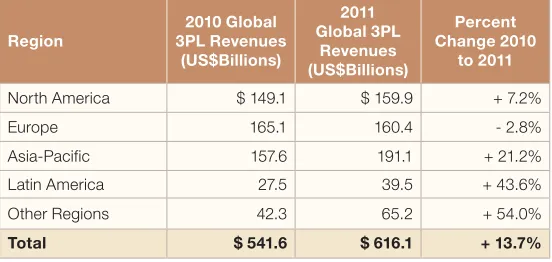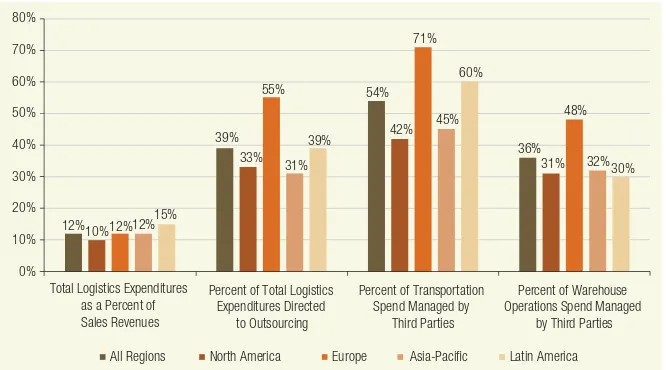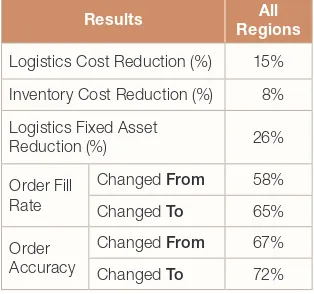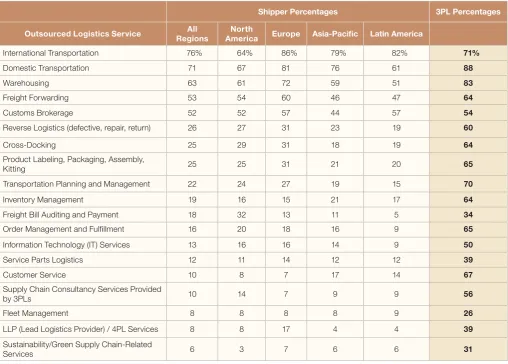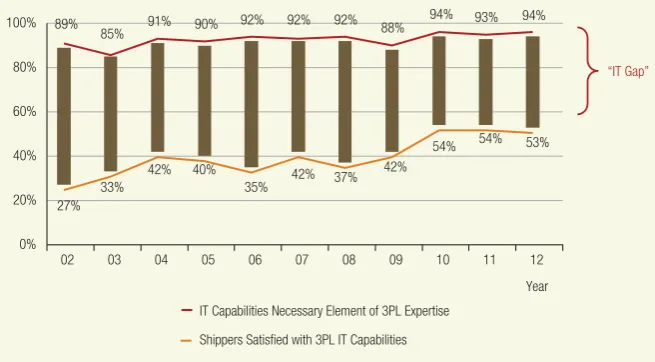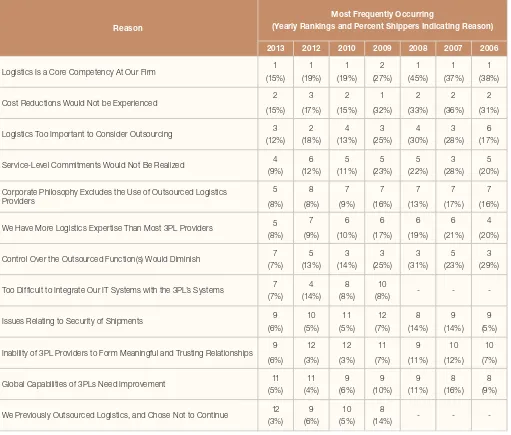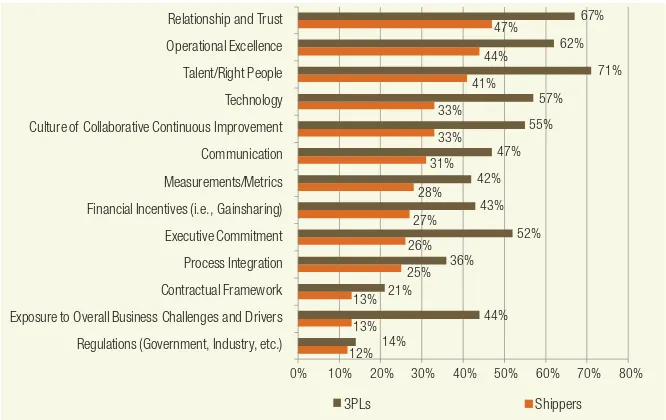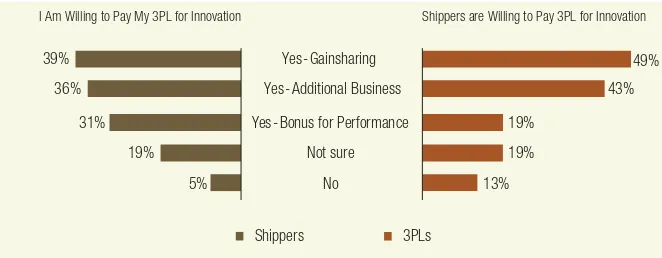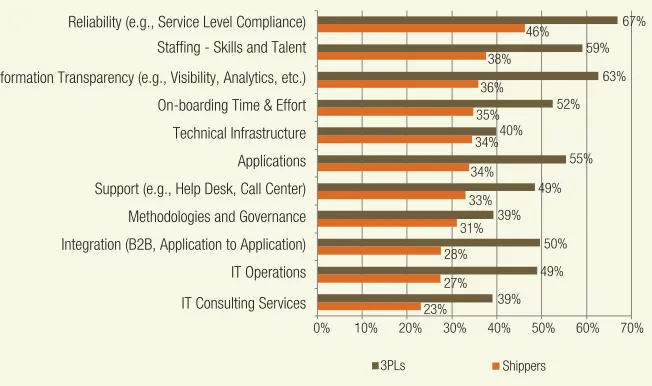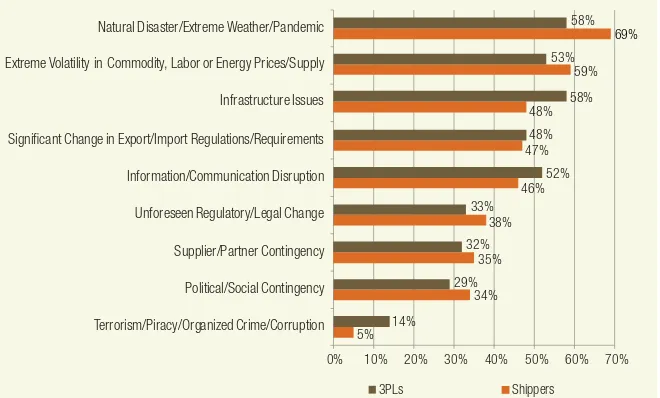2013
Third-Party Logistics Study
The State of Logistics Outsourcing
3
Table of Contents
Executive Summary
4
Current State of the 3PL Market
7
Supply Chain Innovation
15
The
IT
Gap
20
Supply Chain Disruption
22
Talent Management
28
Strategic Assessment
30
About the Study
34
About the Sponsors
37
Supporting Organizations
A N A L Y T I C S
Brief
case
CEDOL CELSCCenter for Emerging Logistics and Supply Chains
I W L A International Warehouse Logistics Association
Transport Intelligence
FreightWatch
I N T E R N A T I O N A L
Current State of the 3PL Market
The success of the third-party logistics industry is evident in the generally high marks given to 3PLs by respondents to a survey as part of the 2013 17th
Annual Third Party Logistics Study, which identifies trends and explores how both 3PLs and shippers are using these relationships to improve and enhance their businesses and supply chains. A substantial 2,342 industry executives provided usable responses to the survey, including users and non-users of 3PL services as well as 3PL providers.
Despite challenging business
conditions, aggregate global revenues for the 3PL sector continue to rise, and far more shippers (65%) are increasing their use of 3PL services than returning to insourcing (22%) some 3PL services. Nearly three in five (58%) shippers are reducing or consolidating the number of 3PLs they use. Shippers report spending an average 12% of revenues on logistics, and an average 39% of that figure is spent on outsourced logistics services. Outsourcing accounts for 54% of shippers’ transportation spend and 39% of warehouse operations spend. As found in past Annual 3PL Study
surveys, transactional, operational, and repetitive activities such as transportation, warehousing, and freight forwarding tend to be the most frequently outsourced.
Both shippers (86%) and 3PL providers (94%) largely view their relationships as successful, with shippers posting some impressive results from outsourcing: just over half (56%) say their use of 3PLs has led to year-over-year incremental benefits. They also report significant savings from logistics cost reductions (15%), inventory cost reductions (8%) and logistics fixed asset reductions (26%). Shippers are more satisfied than 3PLs (71% to 63%) with the openness, transparency and good communication in their relationships, and 67% of shipper respondents judge their 3PLs as sufficiently agile and flexible.
Shippers’ openness to more strategic 3PL-shipper arrangements, including gainsharing and collaboration with other companies, appears to be declining somewhat. The IT Gap appears to have stabilized over the last few years, with 94% agreeing that IT is a necessary element of 3PL capability but just 53% indicating they are currently satisfied with 3PL IT capabilities. Contributors and potential solutions to this disparity are explored in the IT Gap section.
Supply Chain Innovation
Innovation is a critical driver of growth, differentiation, and profitability, but as the logistics industry matures and markets become more global, innovation in this industry is becoming more challenging. The solution lies in evolving toward fundamental changes in 3PL-shipper relationships.
Until recently, 3PLs could demonstrate innovation by introducing process improvements, adding technology, improving execution, or offering new services. But shippers no longer see these as truly innovative, instead seeking disruptive innovation: a new product or service idea that when implemented significantly disrupts a market and/or value chain by simplifying, automating, generating value, or reducing costs.
Many 3PL-shipper relationships are not set up to support innovation. They are tactical rather than strategic, offer insufficient visibility and are limited by metrics, contract terms, and risk mitigation strategies. Most 3PL respondents (89%) believe they are ready to innovate, but just 53% of shippers agree. 3PLs and shippers each see themselves as the largest sources of innovation within their relationships.
Shippers and 3PLs largely agree on the top requirements for innovation, including trusting relationships, talent/right people, and operational excellence. The unifying theme of the results is that it takes truly collaborative
and strategic relationships among all partners to develop the types of disruptive innovations needed to solve the vexing challenges facing today’s supply chains. Current industry consensus is that 3PLs and shippers can facilitate supply chain innovation by leveraging
organizational and technology-focused capabilities. Organizational drivers include fostering collaboration through structure, relationship governance, and embedding innovation into the organization. Technology drivers include advanced IT and mobile solutions, big data and analytics, and social media.
Shippers assert that they are willing to pay 3PLs for investments required to drive innovation. Despite its limited use, gainsharing is the most favored method to fund this investment.
The IT Gap
The long-standing gap between the importance shippers assign to 3PLs’ IT capabilities and their satisfaction with 3PLs’ current IT capabilities – which we call the IT Gap – has stabilized at roughly a 40-point delta. The reason may be an ongoing disconnect between how the two groups view 3PL IT investments: 3PLs are more likely to describe their IT investments as aggressive compared to shippers, while shippers are much less likely to call 3PL investments aggressive (12% vs. 23% for 3PLs), and 35% say they’re conservative. Shippers’ relationships with 3PLs’ IT organizations are also less than ideal: 46% call these relationships project-focused, 29% tactical, and 14% are contentious.
Shippers want 3PLs to offer
that includes IT, will further improve shipper satisfaction with 3PLs’ IT capabilities, drive increased innovation, and improve 3PL-shipper relationships.
Supply Chain Disruption
Extended supply chains, reduced inventories, and shortened product lifecycles are just some of the factors making disruption of supply chain operations more likely and more costly than ever. Economic losses from supply chain disruptions increased 465% between 2009 and 2011. Shippers report adverse weather as the biggest source of supply chain disruption, followed by extreme volatility in commodity, labor, or energy prices/ supply.
Many 3PL and shipper respondents say their organizations are placing a greater focus on supply chain risk and mitigation, with partnerships, business continuity planning, supply chain visibility tools, and employee training/talent management as their top strategies. All are valuable contributors to a comprehensive risk mitigation strategy. Equally notable are the approaches not highly ranked, such as supplier scorecarding and supply chain mapping, essential first steps to identifying and monitoring risk.
The top reason many shippers and 3PLs fall short on their supply chain disruption risk mitigation efforts is a lack of understanding of available mitigation tools. Other common reasons include lack of capital and a belief that current risk mitigation capability is not a problem. Other missteps include: actively monitoring only direct suppliers and not sub-suppliers, and failing to follow through on plans crafted hastily after a disruption.
Companies that have successfully implemented effective supply chain mitigation plans often apply new thinking to traditional mitigation strategies, such as diversifying rather than consolidating suppliers. Clear-eyed assessment of the current state of the network is the first step to understanding the risk, followed by a well-considered plan of attack to both alleviate the biggest sources of vulnerability and respond when disruptions do occur. A sound mitigation strategy can both avoid
costs and help create a competitive advantage.
Talent Management
Several industry surveys have found that CEOs consider talent their most important challenge behind business growth. The right talent is essential to driving innovation and managing potential supply chain disruptors. In last year’s 2012 16th Annual 3PL Study, shippers and 3PLs agreed that having the right people and leadership in place would be the number one driver of their companies’ success over the next five years.
Top tools used by 3PLs and shippers to mitigate supply chain disruptions include employee training, talent management, and internal and external certifications, and many plan to invest accordingly.
Talent is also essential to support the growing demand for logistics innovation. One area where 3PLs are responding to this need is in IT; in recent months many leading 3PLs have been recruiting experienced CIOs and best-in-class IT talent in response to customer demands. Shippers are also taking action; in some organizations the IT function and supply chain organization are being merged based on the strong dependency of logistics on the availability of timely, accurate, and relevant data.
Strategic Assessment
The study team continually monitors current topics in the overall supply chain industry as well as findings that emerge from the research. The following is a brief look at some timely subjects being considered for further exploration in next year’s Annual 3PL Study.
X-shoring: We introduce the term “X-shoring” to address shippers’ moves toward rebalancing supply chains to be more flexible and adaptable, suggesting that shifting global economic conditions may frequently change preferred sourcing locations. The issues shippers confront in making X-shoring decisions to cope with a fluctuating global economy mirror those faced across the enterprise. Making these choices requires better data and improved decision-making strategies,
such as employing total landed cost versus cost of goods sold, assessing risk/quality/service-related costs, and learning to spot “caution flags.” Such insights will enhance shippers’ ability to employ world-class supply chain management to drive profitability.
Global Trade Management: Most companies believe global trade management is essential as they rely more heavily on global trade for growth in a weak economy. However, issues such as shifting trade lanes and new free trade agreements are making global trade more complex. Challenges include maintaining visibility of all purchase part information, coordinating free trade agreement information with suppliers, and ensuring qualification for different trade programs. Shippers that invest time and resources into global trade management best practices will be positioned to transform their global operations into a competitive advantage over their competitors.
Big Data: Growing data volumes (sometimes called Big Data) generated from increased monitoring of more aspects of supply chain operations with greater frequency and granularity has emerged as a disruptive innovation opportunity for shippers and 3PLs. Converting this data into business value is the heart of the challenge and a driver for expanding 3PL relationships. To capitalize on this opportunity, 3PLs must be competent data managers, provide specialized IT tools, facilitate analysis, and adopt a knowledge-centric approach to their relationships with shippers.
5 Executive Summary
Companies that
have successfully
implemented
7
Region
2010 Global 3PL Revenues
(US$Billions)
2011 Global 3PL
Revenues (US$Billions)
Percent Change 2010
to 2011 The third-party logistics industry has
come a long way in its relatively short history, a maturity curve that has been documented in the seventeen years of this study. Early on, shippers cautiously entrusted 3PLs with a relatively limited number of core services, such as managing warehousing and transportation, then steadily asked 3PLs to do more. 3PLs honed their craft in delivery of these services, while gaining shippers’ trust and building toward more collaborative, integrated relationships with their customers.
That progress is reflected in the generally high marks given to 3PLs by respondents to a survey as part of the
2013 17th Annual Third Party Logistics
Study, which tracks trends in 3PL-shipper relationships and explores how both types of organizations are using these relationships to improve and enhance their businesses and supply chains. A substantial 2,342 industry executives completed usable surveys, including users and non-users of 3PL services (referred to as shippers or shipper respondents throughout this report) as well as firms that provide 3PL services (called 3PL respondents). Please see the About the Study section for more information on the research and survey respondents.
Shipper respondents overwhelmingly call their relationships with 3PLs successful, crediting them with providing new and effective ways to improve logistics effectiveness. They say 3PLs are sufficiently agile and flexible to accommodate future business needs and challenges. Shippers are also happy with the openness, transparency, and communications experienced in their relationships with 3PLs.
But at the same time, the pace of progress toward the advanced end of the maturity model for 3PLs-shipper relationships seems to have slowed. Trust levels, technical challenges,
and risks required to create these highly evolved relationships, as well as the continuing impact of the recent recession, are certainly factors in this development. Results also indicate that Asia-Pacific and Latin America supply chains are in a somewhat earlier stage of maturity than those in North America and Europe.
How the Global Economy Impacts Use of 3PLs
Economic volatility and uncertainty continue to affect global business markets and in turn, global markets for 3PL services. As seen in estimated data from Armstrong & Associates in Figure 1, global 3PL revenues for 2010 of $541.6 billion (US dollars) increased by 13.7% to $616.1 billion (USD) in 2011. This reflects ongoing globalization and increasing business for the world’s 3PL providers. Aside from the obvious adverse impacts on global 3PL revenues in the 2007-2009 timeframe, the 3PL sector has continued to grow in recent years.
The geographic breakdowns in Figure 1, which align with the four major geographies that are included in the 2013 3PL Study, highlight the distinctions among markets. Asia-Pacific (+43.6%) and Latin America (+54.0%) are growing dramatically in their use of outsourced logistics. North American 3PL revenues are increasing
at a much lower rate (+7.2%), reflecting the maturity of its 3PL market, while Europe’s economic challenges can be seen in the modest shrinking (-2.8%) of 3PL revenues.
Creating Value Moving Back into Focus
Despite the ongoing economic volatility, shippers and 3PLs seem to be returning to some level of stability in their business relationships. Shippers are fine-tuning their objectives of improving business practices through use of outsourced logistics services, while 3PLs are working to streamline their operations so they can deliver high levels of service to their customers and acceptable financial results for their stakeholders.
According to Dan Albright, Vice President at Capgemini Consulting, “3PLs and their customers have had their ‘heads-down’ for some time as they are engaging in individual and collective efforts to enhance their businesses through the effective provision and use of outsourced logistics services.”
Figure 1: Global 3PL Revenues Up for 2010-2011
Source: Armstrong & Associates, 2012
Current State of the 3PL Market
Satisfaction Remains High, But Expansion Opportunities Remain
Two other high priorities for shippers and 3PLs are driving supply chain innovation as well as mitigating or eliminating supply chain disruption. Organizations that do either or both of these successfully create critical differentiation in the marketplace that can drive competitive advantage. The study team explores both of these in-depth as part of this year’s special topics coverage. The report also briefly considers the critical role talent management plays in attaining supply chain innovation and disruption capabilities, as well as the drivers and obstacles behind the ongoing gap between shippers’ expectations and 3PLs’ capabilities when it comes to IT.
What Respondents Spend on Logistics and 3PL Services
Shipper respondents devote an average 12% of their total sales revenues to logistics, and an average 39% of that goes to outsourcing logistics (Figure 2). While the 12% remains constant from previous studies, the 39% devoted to outsourcing is down only slightly from the 42% reported in last year’s study. Total logistics expenditures include transportation, distribution, warehousing, and value-added services. Considering Armstrong & Associates’ estimated and projected increases to global 3PL revenues cited in Figure 1, these percentages support the finding that global markets for 3PL services are expanding.
Figure 2 also shows dramatic differences across geographies in the percentages of transportation and warehousing spend managed by third parties. Shipper respondents report that on average, outsourcing accounts for 54% of transportation spend, but these range from a low of 42% in North America and 45% in Asia-Pacific to 60% in Latin America and 71% in Europe. Asia-Pacific’s 45% is down dramatically from the 60% shippers reported last year, which may be explained by a modest decrease in Asia-Pacific shippers that are reporting increased use of outsourcing logistics services this year.
The percentage of shippers
outsourcing warehouse operations is down slightly across all geographies except Europe, where it grew from 42% to 48% this year. This increased outsourcing of warehouse operations may be explained somewhat by the significant economic issues that have recently been impacting European business activity.
Outsourcing Outpaces Insourcing
Similar to other industries, shippers (customers) sometimes revisit their decisions to use 3PLs, even over short periods of time. Overall, however, results of this study suggest that far more companies increase their logistics outsourcing in any given year than
Figure 2: Outsourcing Spending Patterns Persist
12%
All Regions North America Europe Latin America Total Logistics Expenditures
as a Percent of Sales Revenues
Percent of Total Logistics Expenditures Directed
to Outsourcing
Percent of Transportation Spend Managed by
Third Parties
Percent of Warehouse Operations Spend Managed
by Third Parties
Asia-Pacific
those that bring most logistics services back in-house – which helps to explain some of the overall increase in global 3PL revenues discussed earlier. The measurement of these outsourcing/ insourcing trends tend to remain fairly stable year over year:
- Outsourcing:65% of shipper respondents report increases in their use of outsourced logistics services this year, compared with 64% and 65% in the last two years. North American growth lags the other regions by a modest amount. Three-quarters of 3PL respondents see an increase in outsourcing among their shippers.
- Insourcing: Generally, insourcing remains less prevalent, with 22% of global shippers indicating they are returning to insourcing many of their logistics activities. One region that evidences significant change from previous results is Europe, which dropped from 18% last year to 12% this year. 3PL reports of shippers in general returning to insourcing many of their logistics activities remains consistent at 37%.
- Reducing or Consolidating 3PLs: The ongoing trend toward strategic sourcing that is occurring at many shipper firms shows up in the number who report they are reducing or consolidating the number of 3PLs they use, an average 58% globally.
This is consistent with previous years’ findings and remains pretty constant across geographies as well. Interestingly, 3PLs are more likely than shippers (72%) to report that in general they see shippers reducing or consolidating the number of 3PLs they use.
So while rates of change to outsourcing/insourcing appear to remain stable in recent years, the general trend among global shippers is to increase their use of outsourced logistics services.
3PL services has led to year-over-year benefits. The biggest declines are in Asia-Pacific (60% to 51%) and Latin America (63% to 48%) – also indicators that those regions are at a different point in the maturity of 3PL usage than North America and Europe.
The Challenge of Enhancing
3PL-Shipper Relationships
Since this study began including 3PLs with their own version of the survey four years ago, a pattern has emerged just like the one above: 3PLs’ ratings of various aspects of their own capabilities and relationships tend to be higher than those given to them by shippers. Their ratings of shippers, however, are not always quite so high. That certainly applies for these 3PL characteristics:
- Openness, transparency and good communication:Similar to last year the 2013 3PL Study
survey showed 71% of shipper respondents are satisfied with 3PLs’ openness, transparency, and communication. But just 63% of 3PLs respondents are satisfied with these characteristics in their customers, creating an opportunity for improvement.
- Agility and flexibility to
accommodate current and future business needs and challenges: Nearly all (97%) 3PLs feel that their customers expect these qualities in their 3PLs. But just 67% of shipper respondents judge their 3PLs as sufficiently agile and flexible – another opportunity for enhancement.
A popular topic in 3PL-shipper relationships is the ability for
participants in the logistics outsourcing arena to reach the highest levels on the maturity curve when it comes to 3PL-shipper relationships. In the throes of the recession, there were some signs that shippers were becoming more open to newer ideas that would improve efficiency and effectiveness in innovative ways, but issues around trust, risk, and even technical obstacles slowed adoption.
Measurable Satisfaction and
Success
3PLs are primarily meeting shippers’ expectations. An average of 86% of shipper respondents view their 3PL relationships as generally successful, compared with 94% of 3PL respondents. Shippers’ ratings are consistent across North America (90%), Europe (90%), and Asia-Pacific (85%). But success ratings for Latin America slipped from 87% last year to 76% this year. Some of this drop may be attributed to the dramatic increase reported earlier in the use of 3PLs by shippers in Latin America. Nearly all (94%) 3PLs respondents view their relationships with shippers as having been successful.
As seen in Figure 3, shippers report impressive results through use of 3PL services, numbers that have remained relatively consistent over time. Where we do see some variation year over year is in order fill rate and order accuracy. While shippers do attribute improvement in these factors to the use of 3PLs, the percentages themselves are somewhat lower than we have reported in the past few years. This may be related in some way to the prevailing global economic uncertainty, a topic that warrants closer examination in future Annual 3PL Studies.
Figure 3: 3PLs Delivering
Measurable Benefits to Shippers
Results All
Regions
Logistics Cost Reduction (%) 15%
Inventory Cost Reduction (%) 8%
Logistics Fixed Asset
Reduction (%) 26%
Order Fill Rate
Changed From 58%
Changed To 65%
Order Accuracy
Changed From 67%
Changed To 72%
Source: 2013 Third-Party Logistics Study
As with past years, just over half of shipper respondents (56%, down from 60% last year) report their use of 3PLs has led to year-over-year incremental benefits, while 87% of 3PL providers say their customers’ decisions to use
Perhaps for those reasons, as well as some improvement in economic conditions, our research reveals recent declines in the openness of some shippers to more innovative 3PL-shipper arrangements:
• “Gainsharing” between 3PLs and shippers is down. Two years ago, more than half of shippers (56%) reported having engaged in gainsharing arrangements with 3PLs. Last year it fell to 42% and this year it’s 37%. The lower percentages seem to be driven by year-over-year reductions in Asia-Pacific (46% to 35%) and in Latin America (a very striking 54% to 34%). Shippers in these regions appear to be more comfortable with fee-for-service arrangements, rather than incentive-based arrangements. More than half of 3PLs respondents (54%) say they have engaged in gainsharing agreements with customers, consistent with past reports.
• Interest in collaborating with other companies, even competitors, to achieve logistics cost and service improvements is also down. This strategy has not been wildly popular during the years we included it in the survey, with just 41% of shipper respondents this year reporting use of collaboration to achieve logistics cost and service improvements compared to 44% in last year’s study. Our interpretation is
9
Current State of the 3PL Market
Our research reveals
recent declines in the
openness of some
shippers to more
innovative
not that shippers regard collaboration as unimportant, but rather that many 3PLs and shippers addressed collaboration first by seeking to establish an industry standard, rather than initially involving only a small number of partners to prove the concept, and subsequently expanding the resulting platform to others.
As indicated in the next section, many shippers prefer 3PL relationships that are tactical and/or operational rather than strategic, making approaches such as gainsharing and collaboration less of a fit with their current methods for managing 3PL relationships.
3PLs’ Advanced Capabilities Less Tapped
Whether it’s disinterest or the difficultly in overcoming trust and risk obstacles that is stalling progress of 3PL-shipper relationships along the maturity curve, the evidence of such stagnation shows up each year in the list of 3PL service offerings and those services shippers used. This year, the two are combined into Figure 4 to reveal the extent of the contrast.
Typically, 3PLs develop a substantial number of services to respond effectively to customers’ logistics needs. Yet each year, we find
transactional, operational, and repetitive activities tend to be the most frequently outsourced. These include international and domestic transportation (76%
and 71% across all regions studied), warehousing (63%), freight forwarding (53%), and customs brokerage (52%).
The less-frequently used 3PL services tend to be somewhat more strategic, customer-facing, and IT-intensive, such as order management and fulfillment (16%), IT services (13%), supply chain consultancy services (10%), fleet management (8%), customer service (10%), and LLP/4PL services (8%).
Another little-used 3PL offering is sustainability/green supply chain-related services (6%). Green supply chain has seen varying levels of interest since we studied the topic closely for the 2008 3PL Study. This year, 52% of shippers say fuel efficiency and carbon emissions have become an important part of their 3PL procurement decision
Shipper Percentages 3PL Percentages
Outsourced Logistics Service All
Regions
North
America Europe Asia-Pacific Latin America
International Transportation 76% 64% 86% 79% 82% 71%
Domestic Transportation 71 67 81 76 61 88
Warehousing 63 61 72 59 51 83
Freight Forwarding 53 54 60 46 47 64
Customs Brokerage 52 52 57 44 57 54
Reverse Logistics (defective, repair, return) 26 27 31 23 19 60
Cross-Docking 25 29 31 18 19 64
Product Labeling, Packaging, Assembly,
Kitting 25 25 31 21 20 65
Transportation Planning and Management 22 24 27 19 15 70
Inventory Management 19 16 15 21 17 64
Freight Bill Auditing and Payment 18 32 13 11 5 34
Order Management and Fulfillment 16 20 18 16 9 65
Information Technology (IT) Services 13 16 16 14 9 50
Service Parts Logistics 12 11 14 12 12 39
Customer Service 10 8 7 17 14 67
Supply Chain Consultancy Services Provided
by 3PLs 10 14 7 9 9 56
Fleet Management 8 8 8 8 9 26
LLP (Lead Logistics Provider) / 4PL Services 8 8 17 4 4 39
Sustainability/Green Supply Chain-Related
Services 6 3 7 6 6 31
Figure 4: 3PLs Offer More Logistics Services than Most Shippers Use
11
processes. But just 26% of shipper respondents rely on 3PLs to provide visibility to fuel efficiency and carbon emissions information. The biggest changes occurred in Asia-Pacific, where the percentages dropped and are now more aligned with the figures for all regions. In Latin America 60% of shippers now see this data as important, but fewer (15%) are relying on 3PLs to provide this type of information.
3PLs’ IT Underdelivering, but Also Underused
Shippers’ propensity to view 3PLs tactically rather than strategically is also reflected in their views of 3PLs’ IT capabilities. As seen in Figure 5, the IT capabilities shippers feel 3PLs must have relate moreso to execution-oriented activities and processes such as transportation, warehouse/ DC management, electronic data interchange, visibility, etc., while capabilities that support more strategic and analytical services are lower-ranked. For 11 years this study has tracked a measurable difference between shipper’s opinions on whether they feel information technologies are a necessary element of 3PL expertise, and whether they are satisfied with their 3PL providers’ IT capabilities. We have referred to this as the “IT Gap.”
Figure 6 reveals that over the long term, this gap has narrowed significantly. However, over the last three years the gap appears to have stabilized to some degree. Interestingly, 70% of 3PL respondents feel their customers are satisfied with the IT services provided by 3PLs. Please see the IT Gap section, which explores some of the drivers behind shippers’ expectations of 3PL capabilities as well as factors that inhibit clear communication between shippers and 3PLs.
Information Technologies
Percentages Reported By
Shippers 3PL
Providers
Transportation Management (Execution) 72% 84% Electronic Data Interchange (Orders, Advanced
Shipment Notices, Invoicing) 68 79 Transportation Management (Planning) 67 80 Warehouse/Distribution Center Management 64 78 Visibility (Order, Shipment, Inventory, etc.) 60 75 Web Portals for Booking, Order Tracking, Inventory
Management, and Billing
59 72
Bar Coding 50 60
Transportation Sourcing 45 58
Global Trade Management Tools (Customs Processing
and Import/Export Document Mgt.) 43 42 Customer Order Management 41 64 Collaboration Tools (SharePoint, Lotus Notes, Video
Conferencing, etc.) 32 41
Supply Chain Planning 30 59
Network Modeling and Optimization 30 44 Supply Chain Event Management 26 49 Advanced Analytics and Data Mining Tools 26 39
RFID 24 36
Yard Management 17 28
Figure 5: Shippers Still Prioritize Execution-Oriented 3PL IT Capabilities
Figure 6: The “IT Gap” Stabilizing
89%
85% 91% 90%
92% 92% 92%
88% 94% 93% 94%
27% 33%
42% 40%
35% 42% 37% 42%
54% 54% 53%
0% 20% 40% 60% 80% 100%
02 03 04 05 06 07 08 09 10 11 12
Year
IT Capabilities Necessary Element of 3PL Expertise
Shippers Satisfied with 3PL IT Capabilities
“IT Gap”
Current State of the 3PL Market
The Alternative View: Thoughts from Non-Users of 3PL Services
The Annual 3PL Study has long invited shippers who classify themselves as non-users of 3PL services to provide some insight into their (current) decision not to outsource. Figure 7 features a seven-year look-back at the percentages of non-users indicating why they are not currently using or considering the use of 3PL services. Top-ranked reasons continue to be a feeling that logistics is a core competency of the organization, a belief that cost reductions would not be realized through outsourcing, and shippers viewing logistics as “too important to consider outsourcing.”
It is interesting to note that the reasons for non-users electing not to use 3PLs have diminished over time. For example, from 2006 to 2008 the percentages of shippers selecting “logistics is a core competency at our firm” as a reason not to outsource were 38%, 37% and 45%, respectively. This contrasts markedly with data for 2010 (19%), 2011 (19%), and 2012 (15%). This suggests two things: First, over time there are fewer reasons why firms choose not to outsource. Second, in the past, non-users had more reason to question 3PLs’ capabilities and competencies. Now, they seem to be conceding that 3PLs have improved – but they still feel they can do it better.
Reason
Most Frequently Occurring
(Yearly Rankings and Percent Shippers Indicating Reason)
2013 2012 2010 2009 2008 2007 2006
Logistics Is a Core Competency At Our Firm 1 (15%)
Cost Reductions Would Not be Experienced 2 (15%)
Logistics Too Important to Consider Outsourcing 3 (12%)
Service-Level Commitments Would Not Be Realized 4 (9%) Corporate Philosophy Excludes the Use of Outsourced Logistics
Providers
We Have More Logistics Expertise Than Most 3PL Providers 5 (8%)
Control Over the Outsourced Function(s) Would Diminish 7 (7%)
Too Difficult to Integrate Our IT Systems with the 3PL’s Systems 7 (7%)
Issues Relating to Security of Shipments 9 (6%)
Inability of 3PL Providers to Form Meaningful and Trusting Relationships 9 (6%)
Global Capabilities of 3PLs Need Improvement 11 (5%)
We Previously Outsourced Logistics, and Chose Not to Continue 12 (3%)
Figure 7: Reasons for Not Using 3PLs Change Over Time
The reasons for
non-users electing not
to use 3PLs have
diminished over time.
13 Current state of the 3PL Market
Key Takeaways
Key findings about the Current State of the Market for the 2013 17th Annual 3PL
Study include:
t Despite the continuing volatility of global business environments, 3PLs are continuing to improve their business presence and create value for their customers. Aggregate global revenues for the 3PL sector continue to rise, particularly in Asia-Pacific and Latin America. A majority of shipper respondents (65%) are increasing their use of 3PL services, while 22% are returning to insourcing some 3PL services and 58% are reducing or consolidating the number of 3PLs they use.
t Total logistics expenditures remain consistent at 12% of sales revenues for shipper respondents, and they spend on average 39% of their total logistics expenditures on outsourcing. Outsourcing accounts for 54% of shippers’ transportation spend and 39% of warehouse operations spend.
t Similar to last year’s results, most shipper respondents (86%) and most 3PL providers (94%) view their relationships as successful. Shippers report measurable logistics cost, inventory cost and logistics fixed asset reductions, and just over half (56%) say their use of 3PLs has led to year-over-year benefits.
t Shippers are more satisfied than 3PLs (71% to 63%) with the openness, transparency, and good communication in their relationships, and 67% of shipper respondents judge their 3PLs as sufficiently agile and flexible.
t Our measures indicate that the openness of some shippers to more innovative 3PL-shipper arrangements appears to be declining somewhat; “gainsharing” between 3PLs and shippers is down and interest in collaborating with other companies, even competitors, to achieve logistics cost and service improvements has also declined slightly since last year.
t Consistent with the past,
transactional, operational, and repetitive activities tend to be the most frequently outsourced, in relatively consistent numbers, while 3PLs’ more strategic capabilities are underused, including IT capabilities.
t Over the long term, the gap has narrowed between the value shippers place on 3PL IT capabilities (94% this year) and how they feel 3PLs are meeting their expectations (53%), but this IT Gap appears to have stabilized somewhat over the last few years.
15
Supply Chain Innovation
Shippers Seek Bold, Disruptive Solutions
Supply Chain Innovation
Innovation is widely viewed as essential to the long-term success of an
organization. 3PLs and shippers can’t simply continue to make incremental improvements to what they do now; constant innovation is required to discover new paths to growth and differentiation. But innovation is becoming more challenging as the logistics industry matures and markets become more global. Fundamental changes are required in 3PL-shipper relationships to create a foundation for the innovation shippers need to solve their supply chain challenges.
The Changing Rules of Innovation
Innovation is defined as the creation of better or more effective products, processes, services, technologies, or ideas that are accepted by markets, governments, and society (shippers and 3PLs). New ideas are invented, but it takes innovation to put those new ideas to use in the real world.
“Many 3PLs are too reactive,” said Quentin Tse, Formerly VP Network Strategic Sourcing, Ericsson North America, at the Jersey City Accelerated Solutions Environment. “They need to become more proactive. 3PLs and customers need embedded partnerships where 3PLs are more strategically involved with their customers.”
Until recently, 3PLs could demonstrate innovation by introducing process improvements, adding technology, improving execution, or offering new services such as order management, customer service, or transportation planning. But as seen in Figure 4 in the Current State of the 3PL Market, many such additional services were
not always created in response to true customer demand.
The underlying message: Shippers increasingly believe that these process improvements are not sufficient to drive their supply chains. Innovation needs to be more significant, and 3PLs and shippers need to work on game-changing innovations to compete in today’s environment.
“All of my 3PLs can innovate. This is part of the selection of partners,” says Johan Jemdahl, Vice President, Supply Chain Operations EMEA, at Cisco Systems. “But it’s about disruptive innovation and how providers can help us change the game to improve our supply chain.”
Innovation is the term used in most supply chain discussions – and in the questions put to respondents as part of the survey and used throughout this report. But what these shippers are really seeking is disruptive innovation. A disruptive innovation is a new product or service idea that when implemented significantly disrupts a market and/ or value chain by either simplifying, automating, generating value, or reducing costs. It helps create a new market and value network by disrupting an existing market and value network and displacing an earlier product or service. Examples of disruptive innovations include cell phones versus wireline phones, and RFID tagging.
What Is Changing
Shippers are being pressured by multiple factors that must be addressed in their supply chains. Competition and pricing pressures are driving them to
seek lower labor and manufacturing costs around the world while also minimizing the effect of taxes and tariffs. As they are extending to new markets for both sourcing and sales, shippers are also constantly revisiting old sourcing decisions and in some cases pulling production closer to target markets. All of this means supply chains are growing increasingly complicated and more susceptible to disruption.
As a result, shippers are seeking increasingly relevant supply chain innovations that reduce costs as well as add value, supporting needs such as new product marketing, developing market entry, logistics/IT integration, or sustainability initiatives. Several ASE and workshop participants noted that innovation is case-specific. “Innovation for me might not be innovation for others,” said Graham Wilkie, E-Commerce Supply Chain Director at Carrefour, at the study workshop conducted in Paris, France.
Some shippers also seem to lack confidence in 3PLs’ ability to operate at the strategic level necessary for disruptive innovation. The majority of 3PL respondents (89%) to the Annual 3PL Study survey believe they are ready to innovate. But just 53% of shippers agree and another 33% are not sure.
“There is a constant pressure on consistent delivery versus time out to innovate,” said one workshop attendee.
As seen in Figure 8, shippers and 3PLs think of themselves as the largest source of innovation, and the other as the second largest source.
The ability for 3PLs to drive innovation is not just important to satisfy shippers’ evolving needs. It is also necessary for 3PLs to remain profitable. At the ASE in Jersey City, NJ, Jim Carey, Senior Vice President Sales & Marketing at Clancy Companies, noted, “Lack of innovation increases the chance of commoditization. It fosters
commoditization, stagnancy and in the end, obsolescence.”
Enriching Relationships
Fortunately, shippers and 3PLs agree on the factors it takes to develop infrastructure that supports innovation. Shipper respondents (93%) and 3PL respondents (89%) are nearly unanimous in their belief that 3PLs should have a defined structure for innovation.
Even better, as seen in Figure 9, they also agree on the top drivers for innovation, although the order is slightly different. Shippers regard a trusting relationship as the most important driver, while 3PLs rank this second to talent/right people. Operational excellence, a culture of collaborative continuous improvement, and technology round out the top five.
Figure 8: Shippers, 3PLs See Themselves as Top Innovation Originators
Figure 9: Shippers, 3PLs Relatively Aligned on Top Drivers for Innovation 30%
35% 20%
11% 4%
Shippers 36%
28%
3PLs 7%
Where 3PLs Say Innovations Come From Where Shippers Say
Innovations Come From
12%
17%
Consultants Other IT Companies
12% 13% 13%
25% 26% 27%
28% 31%
33% 33%
41% 44%
47%
14%
44% 21%
36% 52% 43% 42%
47% 55%
57% 71% 62%
67%
0% 10% 20% 30% 40% 50% 60% 70% 80%
Regulations (Government, Industry, etc.) Exposure to Overall Business Challenges and Drivers Contractual Framework Process Integration Executive Commitment Financial Incentives (i.e., Gainsharing) Measurements/Metrics Communication Culture of Collaborative Continuous Improvement Technology Talent/Right People Operational Excellence Relationship and Trust
3PLs Shippers
Source: 2013 Third-Party Logistics Study
The Current State of the 3PL Market
section notes a moderate decline of interest in mechanisms that some believe would improve efficiency and effectiveness and drive innovation, such as gainsharing and interest in collaborating with other companies, even competitors. Those results are echoed in these findings: Both shippers and 3PLs gave lukewarm ranking to financial incentives as a driver of innovation. Contractual framework was rated even lower, with only 13% of shippers and 21% of 3PLs calling it a top driver.
“The contract is a framework for our collaboration, but not the actual collaboration,” said Cisco’s Jemdahl. “So much is constantly in motion and happening. There are so many threads of info/input, and as I used to say, ‘Facts aren’t, facts become,’ which tells us that whatever brought us here won’t keep us here. We need talented people to navigate, conceptualize and act on all this. Only humans have that capability. People are responsible, not a ‘project’ nor a ‘contract’ nor a ‘process’.”
Relationships That Foster Innovation
The unifying theme of these results is that it takes true collaborative, strategic relationships among all partners to develop the kind of disruptive innovations it will take to solve the challenges facing today’s supply chains. That represents a considerable change from the way many 3PL-shipper relationships are structured today.
A June 2010 review of current research on logistics service provider innovation by Christian Busse and Carl Marcus Wallenburg, Innovation Management of Logistics Service Providers, found that both 3PLs and shippers can facilitate supply chain innovation by leveraging organizational and technology-focused drivers:
Organizational Drivers:
Fostering Collaboration through Structure: The capacity for 3PLs to innovate is driven by frequent, repeated collaboration with their customers,
because frequent contact builds trust, eases communication, and reduces the instinct for knowledge protection. “More dimensions of relationship bring more opportunity to innovate,” noted a participant at one of the Annual 3PL Study workshops.
For 3PLs this means shifting to a decentralized structure with a seasoned, operations-focused 3PL representative on site at the shipper’s location, where 3PL and shipper can devise tailored solutions free from bureaucracy and standardized approaches. Conversely, the ideal model for a shipper is to create an Innovation Center of Excellence, a think tank focused exclusively on innovation. The success of the Center of Excellence in interacting with internal and external stakeholders to foster and implement innovation is critical for driving disruptive innovation.
Relationship Governance: Simply boosting face time isn’t enough, however. Current 3PL-shipper relationships are too often “single point” and do not bring the right people nor the right relationships into play. A formalized relationship management approach sets the stage for how the partners will drive the business and promote collaboration. Options include:
tA tiered structure that vertically aligns the 3PL’s and shipper’s top management, mid-management, and workforce. Each tier examines the relationship’s tactical, strategic, and transformational performance.
tHorizontal, peer-to-peer mapping that matches employees from both the 3PL and shipper in similar tiers and roles. Once mapped, communications protocols establish how each set of peers can discuss tier-appropriate items. As companies become more global, horizontal integration can support more complex structures and interfaces.
tEmbedding Innovation into the Organization: Perhaps the biggest challenge in fostering disruptive innovation is developing a culture that promotes and rewards it. For
3PLs this often means shifting from a physical mindset focused on day-to-day operational delivery to one based on knowledge, including strategy collaboration and innovation. A transformation management process is a valuable means to create an environment that values innovation and embeds it in the vision.
Murphy Ho, Regional Logistics Manager, Asia, of Celestica, noted this at the Hong Kong workshop: “It’s about relationships, relationships between 3PLs and shippers and also the relationships within organizations and between departments.”
Technology drivers
Advanced IT and Mobile Solutions: As noted in the Current State of the 3PL Market section, the “IT gap” has been reduced by 21% over the past half-decade. But even with that improvement, the gap has stabilized in recent years, with just 53% of users saying their 3PL meets expectations. A major frustration is a lack of visibility. Use of SaaS- and cloud-based solutions together with robust, real-time, anywhere access to data enabled by mobile apps and smartphones hold promise for breaking through this barrier.
Big Data and Analytics: Also offering great potential are technologies to gain control of the huge volumes of data generated by today’s multifaceted supply chains. Emerging big data solutions, paired with robust analytics engines, will empower both 3PLs and shippers to find meaningful patterns and trends in data. That visibility is a key ingredient to revealing new opportunities for innovation.
“Managing the balance between visibility and data is critical to 3PLs and shippers,” says Leanne Hill, Vice President, Global Supply Chain, Duty Free Shoppers. “Getting this right can separate high-performing relationships and drive supply chain success, but to be successful in this area requires close collaboration between shippers and 3PLs.”
Social Media: A growing number of companies are learning to leverage social media to enhance communication across the supply chain. According to Social CRM in the Supply Chain, a fall 2011 report from IDC Research Services, logistics companies using social media identified significantly more benefits than non-users, especially around communication and tracking industry trends. A substantial 88% of respondents reported time savings greater than 10% using social media, and 60% said it improved their satisfaction with a supply chain vendor or partner somewhat or to a great extent. Social media can potentially facilitate the previously addressed horizontal integration model for relationship governance.
Israel-based global generic
pharmaceuticals leader Teva has used social media tools to create a virtual supply chain community for use by internal operations professionals and external suppliers, according to the IDC report. The spontaneous discussion fostered by social media led to an improvement in upstream supply lead time from 15% to 60%, and operational cycle time improved by 40% in four months.
Funding Innovation
Implementing the cultural and technical infrastructure to create an environment that supports development of disruptive innovation requires considerable investment. As seen in Figure 10, shippers assert that they are willing to pay 3PLs for the required investment. Interestingly, despite its relative unpopularity, shippers cite gainsharing as their chief means to fund this investment (49%), followed by additional business and pay for performance. 3PLs agree that shippers are willing to pay them for innovation, but see additional business as the leading method (43%).
Figure 10: Shippers and 3PLs Agree on Top Funding Source for Innovation
Yes - Additional Business Yes - Gainsharing
I Am Willing to Pay My 3PL for Innovation Shippers are Willing to Pay 3PL for Innovation
Yes - Bonus for Performance
5% 36%
No 39%
31%
Not sure
Shippers
13% 19% 19%
43% 49%
19%
3PLs
Supply Chain Innovation: Key Takeaways
t Fundamental changes are required in 3PL-shipper relationships to create the foundation for truly disruptive innovations shippers need to solve their supply chain challenges.
tShippers and 3PLs agree on the top drivers for innovation, although in different order. These are relationship and trust, talent/right people, operational excellence, a culture of collaborative continuous improvement, and technology. Arriving at disruptive innovations requires true collaborative, strategic relationships among shippers and 3PLs.
t Shippers and 3PLs can facilitate supply chain innovation by leveraging organizational drivers such as fostering collaboration through structure, relationship governance, and embedding innovation into the organizations as well as technology-focused drivers: advanced IT and mobile solutions, data and analytics, and social media.
tShippers assert that they are willing to pay 3PLs for the required investment in innovation.
It’s about relationships, relationships between
3PLs and shippers and also the relationships
within organizations and between departments.
The IT Gap
Shippers feel strongly that IT capabilities are at the core of a 3PL’s ability to provide value, as seen in Figure 6 in the Current State of the 3PL Market section. This year’s survey found nearly 25% of 3PLs are responding aggressively to fulfill this need, describing themselves as willing to adopt technologies while they are relatively new and risky — while 52% of 3PLs call their IT investments mainstream and 26% call them conservative.
Yet the difference between what shippers feel is important and their ratings of their 3PLs’ current IT capabilities has stabilized at around a 40-point gap. Shippers are much less likely to call 3PL
investments aggressive (12% vs. 23% for 3PLs), and 35% say they’re conservative. It’s possible that 3PLs are simply not fully informing shippers about their IT capabilities. However, it is more likely that shippers are seeing what they have and finding it lacking.
Similar to the overall 3PL-shipper relationship, shippers are most likely to call their relationship with their 3PL’s IT group project-focused (46%) or tactical (29%), and 14% even describe the relationship as contentious (Figure 11). Just 11% of shippers say it’s strategic, while 3PLs are much more likely (23%) to describe the relationship their IT
department has with their customers as strategic.
Shippers want 3PLs to offer
21 The IT Gap
Figure 11: Relationship between Shippers and 3PL’s IT Group
Figure 12: Percentage of Response of Above Average or Better Ratings for 3PL Capabilities
11%
Shippers’ Current View
Strategic
Tactical
Project-Focused
Contentious 34%
3PLs’ Current View
Shippers’ Desired view
29% 46%
14% 23%
31% 12%
50%
29%
16% 5%
23% 27% 28% 31%
33% 34% 34% 35% 36%
38% 46%
39% 49%
50% 39%
49% 55% 40%
52% 63% 59%
67%
0% 10% 20% 30% 40% 50% 60% 70%
IT Consulting Services IT Operations Integration (B2B, Application to Application) Methodologies and Governance Support (e.g., Help Desk, Call Center) Applications Technical Infrastructure Information Transparency (e.g., Visibility, Analytics, etc.) Reliability (e.g., Service Level Compliance)
3PLs Shippers
On-boarding Time & Effort Staffing - Skills and Talent
Source: 2013 Third-Party Logistics Study
Source: 2013 Third-Party Logistics Study
The good news is that 3PLs are hearing the call. Just over half of 3PL respondents say they are likely to make large investments in modernizing applications, and 65% plan on buying solutions to reduce client on-boarding costs, time, and effort.
But these investments must not be made in a vacuum. 3PLs cannot make the right investments until they have a clear picture of their customers’ supply chains and the challenges they face. Some 3PLs regularly invite their customers to collaborative meetings, where these shippers share the issues they are struggling with and the 3PL develops a solution that they can then go market to other companies, such as developing an execution-based in-transit visibility capability.
A major question is what investment in time and resources is required by both parties to actually develop a strategic IT relationship, and is there enough value realized to justify the investment? These questions challenge the transactional relationship that often exists today, focused on KPIs and cost. More in-depth and timely communication sharing regarding shippers’ challenges and opportunities is required to align 3PLs’ priorities and investments. Ultimately, a collaborative approach to IT planning ensures 3PLs are investing in what shipper’s value, instead of what they think they value. Greater collaboration ensures a more strategic relationship.
23
Supply Chain Disruption
Risk is Increasing, Executive Support and Funding are Lagging
Supply Chain Disruption
Millions of dollars’ worth of airplane fuselage assemblies move through manufacturing lines at a Spirit Aerosystems plant in Topeka, Kansas. When the plant’s managers received a pinpoint warning on April 14, 2012, from AccuWeather that an F3 tornado was on track to hit the facility’s main building in 24 minutes, they jumped to action, taking people out of harm’s way and securing critical parts. The building sustained damage, but Spirit experienced no injuries or inventory losses.
Unfortunately such success stories are not always common – and are becoming even less so. Economic losses from supply chain disruptions increased 465% from 2009 to 2011, reaching a staggering $350 billion, according to the Business Continuity Institute. In that time the number of companies experiencing a supply chain disruption grew 15%.
It appears that disruptions are occurring more frequently and making a bigger impact, affecting more companies and customers globally. Globalization means supply chains are more extended, increasing vulnerability. At the same time, companies are reacting to the economic crisis by drawing down inventories, meaning less safety stock when a disruption occurs. Centralized distribution has focused more production and inventory in fewer places, and in some segments, product lifecycles are growing shorter; both magnify the impact. Companies report taking the biggest hit in productivity, but other significant pain points include higher work costs, lower revenues, and a damaged reputation with customers.
Tighter budgets also mean less money devoted to developing and implementing mitigation strategies and solutions. That means fewer organizations are implementing the
most effective risk mitigation tactics. So when disruptions inevitably occur, they’re caught short.
Multiple Sources of Risk
Tornadoes and tsunamis may be the most dramatic of disasters, but they are far from the only sources of supply chain disruption; breakdowns in IT, energy, or communications are also at fault, as well as failures in business operations, and political and economic factors. Infrastructure deficiencies caused massive power outages in India in late July 2012, for example.
Shippers responding to the Annual 3PL Study survey report adverse weather is the biggest source of supply chain disruptions (Figure 13). Just three events — the Japanese and New Zealand earthquakes and flooding in Thailand – accounted for $58 billion (USD) in insurance losses globally, according to the Business Continuity Institute.
Sudden resource shortages or inflation and currency fluctuations contribute to rising supply chain costs or missing
inputs. Shippers say extreme volatility in commodity, labor, or energy prices/ supply is their second largest source of supply chain disruption.
Transportation infrastructure disruptions were another notable cause: 3PL respondents rated this as their number one source of supply chain disruption. Business operations, both internal and external, can be another frequent cause: A key person in an organization moves to another company, taking all process know-how with them, for example, or a component doesn’t meet quality needs, halting production.
Unplanned outages in IT or
communications systems – including hacking – affected more than half the 3PLs responding to the Annual 3PL Study survey and 40% of companies studied by the Business Continuity Institute. Research published by CA Technologies in November 2011, The Avoidable Cost of Downtime, found two of the three corporate departments most impacted by an IT outage were operations and procurement, both supply chain-related.
Figure 13: Natural Disasters Top Common Causes of Disruption
5% Unforeseen Regulatory/Legal Change Information/Communication Disruption Significant Change in Export/Import Regulations/Requirements Extreme Volatility in Commodity, Labor or Energy Prices/Supply
48% 58%
Infrastructure Issues Natural Disaster/Extreme Weather/Pandemic
3PLs Shippers
Political and economic factors are also causes of disruption. For example, in 2011 civil unrest from the “Arab Spring” impacted firms that rely on suppliers in Middle East or North African nations, particularly those that need the rare minerals and fossil fuels found in these regions.
Supply Chain Complexity Increases Risk
Supply chains are more vulnerable than ever before to negative impact from disruptive events. Logistics networks have expanded to new locations for both sourcing and sales; this often leads to increased outsourcing and more partners. A longer geographic reach also increases the odds that at least one location along the supply chain will experience a disruptive event.
In its report, Supply Chain Resilience 2011, The Business Continuity Institute found 61% of supply chain disruptions came from a direct supplier and 39% from a supplier’s supplier. However, 75% of companies only monitor their Tier One suppliers. This means most companies do not have direct communication with the source of two of every five disruptions.
At the 2013 Annual 3PL Study
workshops, many participants noted that they typically address an unwieldy number of suppliers and sub-suppliers by assigning responsibility for risk mitigation of supplier’s suppliers to their Tier One suppliers in contracts. But in practice, Tier One supplier compliance with this requirement is rarely verified and audited, and is tested even less frequently. Companies lack a tactical approach to identifying the biggest risks across their supply networks, as well as processes for actively mitigating and monitoring these risks.
In interviews with earthquake-impacted companies in early 2012, the Business Continuity Institute found that 29% recovered within a week, 24% required up to a month and 41% took one to six months to get back to normal operations, according to Global Supply Chain Resilience: Lessons Learned from the 2011 Earthquakes.
Opportunity to Improve Risk Mitigation
Both shippers and 3PLs are sensing the increased risk of disruption. Nearly half of 3PLs and shipper respondents agree that their organizations are putting a greater focus on supply chain risk and mitigation than five years ago, and another 29% of shippers and 27% of 3PLs call the focus significantly greater.
As seen in Figure 14, partnerships, business continuity planning, supply chain visibility tools, and employee training/talent management are the top strategies companies currently use to mitigate their supply chain risk, although shippers and 3PLs rank these in a slightly different order. They are also the top strategies shippers and 3PLs are planning to invest in over the next two years.
All are valuable contributors to a sound risk mitigation strategy. Equally notable are the approaches that are not highly ranked, such as supplier scorecarding and supply chain mapping.
Business continuity planning ranks highly and is a somewhat common risk management solution. However, these plans are often one-time projects for many companies. Groups are formed and plans made in the aftermath of a disruption, but no one is assigned adequate responsibility for maintaining processes and monitoring compliance. Over time the commitment fades, and the company is caught off guard when the next disruption ensues.
A more advanced solution is the development of a risk management organization. This group does not have to be large or overly complex, but should have the skills and experience to define cross-functional solutions. This approach often produces more effective and efficient solutions, not relying solely on procurement or partners to identify and execute. Over time the group also spreads the knowledge of risk management so that in the future more employees consider risk in their everyday decisions.
Vendor Risk Assessment Growing More Comprehensive
Credit worthiness is no longer a sufficient indicator of the risk associated with doing business with a particular vendor. Today best practices in vendor risk management dictate assessing every trading partner against multiple financial and non-financial risk categories. Research conducted by vendor risk detection service provider Briefcase Analytics found that companies’ top goals for vendor risk detection are insuring against risk (48%), avoiding surprises (46%), predicting vendor failure (42%), and gaining leverage in negotiations with vendors (37%).
Looking beyond credit risk helps companies understand how a company has achieved its current financial position as well as its relative risk in multiple dimensions. In addition to financial health, a comprehensive vendor assessment examines risk areas including business integrity; privacy and intellectual property; health, safety, and environment; labor and human rights; and sustainability.
The most-used tools for vendor risk assessment, according to the Briefcase Analytics survey:
tContract clauses (83%) tPhysical inspections (69%) tVendor intelligence data (62%) tVendor self-reporting (60%) tVendor codes of conduct (49%)
Sources of data on companies of all sizes, both public and private, have expanded considerably over the past seven years. That’s allowing companies to work toward assessing 100 percent of their trading partners, rather than just public companies. Researchers have identified more than 600 publicly available databases reporting vendor risk data for more than 50 countries.
Figure 14: Shippers and 3PLs Aligned on Current and Future Mitigation Strategies
0% 10% 20% 30% 40% 50% 60% 70%
Disruption News Feeds Insurance Decision Support Tools Supply Chain Mapping Advanced Enterprise Risk Management Organization Supplier Scorecarding Employee Training / Talent Management Supply Chain Visibility Tools Business Continuity Planning Partnerships
3PL Shipper
3PL Shipper
0% 10% 20% 30% 40% 50% 60% 70% Disruption News Feeds
Insurance Advanced Enterprise Risk Management Organization Supply Chain Mapping Decision Support Tools Supplier Scorecarding Business Continuity Planning Employee Training / Talent Management Partnerships Supply Chain Visibility Tools
Current Mitigation Strategies
Future Mitigation Strategies 15%
Supply Chain Disruption 25
Fueling the Problem
Despite growing awareness of the risks of supply chain disruption, many companies have not followed through with significant investment in solutions. Figure 15 reveals that 3PLs and shippers largely agree on the most common reasons for underfunding their supply chain disruption mitigation or response:
tLack of understanding of available mitigation tools. It is apparent that while companies acknowledge the frequency and impact of disruptions, many have done little to investigate the potential tools that are available to manage this risk. In most cases companies depend on partners or business continuity plans for this task.
tCapital unavailable. More than half of shippers (55%) and 3PLs (57%) plan to invest less than $1 million on their supply chain disruption/ mitigation response capability, despite the increasing organizational focus they report on risk mitigation. This relates strongly to the fourth-ranked reason for underfunding: lack of executive commitment. It can be tough to sell the leadership on diverting budget to something that might happen when there are so many competing priorities that must or will happen.
tThe feeling that current risk mitigation capability is not a problem. Often, this belief is a result of the rather short lifespan of institutional memory. Those who experienced the company’s most recent supply chain disruption first-hand move on, and those who follow do not have the same scars or memories.
Several automakers with experience in managing through the disruptions caused by the September 11th attacks and the volcanic ash cloud were quickly reminded of the value of risk mitigation planning following the March 2011 earthquake and tsunami in Japan. The disaster closed down a factory operated by Merck Chemicals International of Germany that serves as the only source of Xirallic® pigments,
Source: 2013 Third-Party Logistics Study
